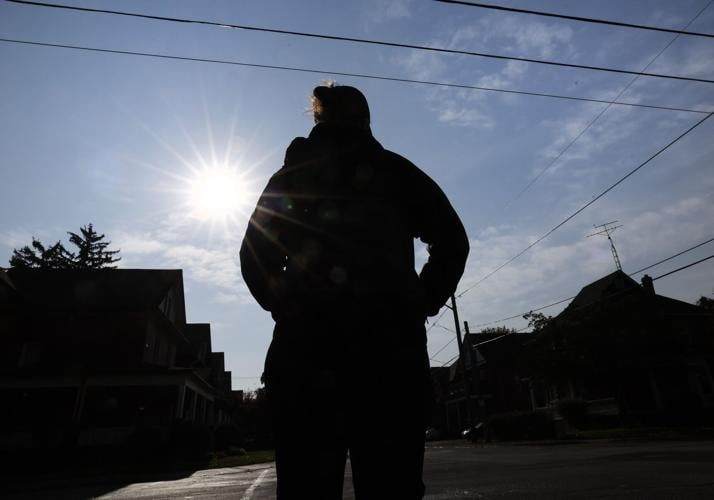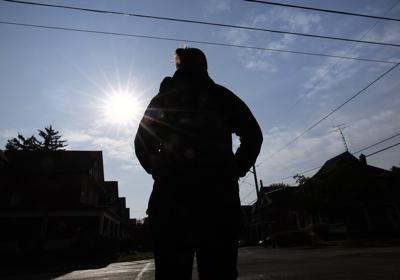One big purchase, rung up without permission on her motherās credit card.Ā
It hadnāt taken much to land a Bowmanville teenager inside a Durham Regional police interview room, all alone with the officer on duty.
A Grade 11 student who adored horses and spent her childhood at the stables, she had started acting out. She was skipping school, experimenting with marijuana, and then came the credit card incident ā the unauthorized purchase, she said, of a videogame console by forging her mom’s signature. So in May 2003, her parents marched her intoĀ the police station, hoping a chat with a cop would scare her straight.Ā
Const. Kevin Seamons was in full uniform, tall and intimidating, the girl recalls. What started as a stern talking-to grew into an hours-long interrogation ā one that would later be called an unjustified detainment without arrest or caution.Ā
It was only the beginning. Over the next seven months, the married father of two initiated what a police misconduct prosecutor called an āintensely involvedā relationship with a high-school girl. Frequent drop-ins to her family home turned into drives in his squad car, visits to the station and a trip out of town, and even out on active calls. Later defending his actions as an attempt to help a troubled youth, Seamons spent scores of hours, one-on-one, with the girl, none of it ever documented in his notes or authorized.
The relationship would end Seamonsā policing career. After it was discovered, other misconduct came to light, including his on-duty theft of pornographic personal Polaroids taken from a womanās bedroom during a domestic call.Ā
That the case never drew headlines was remarked upon in a 2006 decision dismissing Seamons.
āIf details of the allegations against Constable Seamons were made known to the public, the damage to the reputation of the Durham Regional Police Service would be huge,ā wrote Supt. Robert Chapman.
More than 20 years later, the now-grown teenager wants to tell what she says is the full story.Ā
This summer, she filed a lawsuit against Seamons and the Durham Regional Police Services Board alleging she was groomed, stalked and sexually assaulted by Seamons after he took advantage of his unique position of power and authority as a cop. The Durham police force, the lawsuit alleges, then failed to thoroughly investigate, instead ācovering up the abuse.āĀ
The allegations had swift consequences. Ontarioās Special Investigations Unit (SIU), which conducts criminal investigations into police, has now re-opened their historic sexual assault investigation into the case, citing new information provided by Durham police.
āI thought, over the years, that I’d be able to forget and move on, and I can’t,ā said the complainant, now 38, who the Star is not identifying because she is an alleged victim of sexual assault. āI think that at this point in my life I’m ready to face it.āĀ
The lawsuitās allegations have not been proven in court and Seamons has not yet filed a statement of defence. Reached by phone, Seamons, who lives out of province, said: āIāve been told more or less to keep quiet.āĀ
āI donāt know what I should say, allowed to say. Tell you this, Iāve tried to tell my story in the past and nobody wanted to fāing listen,ā he said.Ā
No statement of defence has yet been filed by theĀ Durham Regional Police Services Board, though the board filed a notice of intent to defend in September. A spokesperson for the board said they would not provide any comment.Ā
Durham police confirmed that they notified the SIU about the allegations contained in the lawsuit; a spokesperson for the SIU said their probe was relaunched after Durham police provided new information on Aug. 27. The watchdog isĀ asking anyone with information to come forward.
Kate Puddister, a University of Guelph police researcher who has tracked the outcome of hundreds of sexual assault complaints to the SIU, said victims aged 13 to 19 are the second most common age group, after those aged 20-29. There is a common theme in the alleged assaults of minors, she said.
“In these cases, we see instances of victims turning to the police for help or guidance and then end up being assaulted or abused,” said Puddister, who does not have direct knowledge of the Durham case.Ā
According to the lawsuit, Seamonsā āinappropriate and intense interestā in the teen began the night she was brought into the station by her parents. That evening, the lawsuit alleges, Seamons forced her to remove her pants and lay across his lap. Raised to respect authority, the complainant told the Star she assumed a police officer could make such demands.Ā
Over the next seven months, Seamons āused the implicit trust, authority, and powerā of being a police officer to become close to the girl and her family, the lawsuit alleges. It claims Seamonsā efforts included befriending her parents and offering to provide guidance and mentorship to the teen, randomly calling and coming to the family home while on duty, lurking in front of her school and driving her around in his patrol car and āintentionally and deliberatelyā interfering in her personal affairs.Ā
āHe just completely put himself right in the centre of my life,ā she told the Star.
The lawsuit alleges he began sexually assaulting the complainant, including inside his Durham patrol car and at the station. The assaults, which made her feel āconfused, fearful, shameful, guilty and complicit,ā included stripping her of her clothing and leering at her, groping her breasts, buttocks and vagina, and rape, the lawsuit claims.
Due to his position and because Seamons showed the teen his large collection of guns, she was first āterrified to report the abuse,ā the lawsuit alleges. In December 2003, she disclosed the assaults to her boyfriend; when her mother confronted her, she revealed only part of the abuse, “afraid of what Seamons would do if she disclosed fully,” the lawsuit said.
After the girl’s mom made a report to the Durham police, the force launched an investigation and notified the SIU. The watchdog opened a sexual assault probe, but closed the case without any charges.
Ivanna Iwasykiw, the complainant’s civil lawyer, said the SIU never got the full account of the allegations against Seamons, in part because Durham police discouraged her from providing information that would fall outside the realm of professional misconduct (Durham police did not reply to a request for comment by deadline). The lawsuit alleges there were problems with how the teen was interviewed: she provided five separate statements to police and SIU investigators, was not offered access to a lawyer and could not bring in a guardian or adult for support, and that “at points during the interview, (she) was told not to speak about certain of her allegations.”Ā
But Durham’s internal probe soon confirmed that Seamons had been spending a significant amount of on-duty time with a 17-year-old, with whom he had an “inappropriate” relationship ā one where he was providing a “private police service” to the girl and her family, a ruling from a provincial police appeal body said.
According to a 35-page decision by Chapman, which summarized the case and his reasons for dismissal, Seamons pleaded guilty to 10 counts of professional misconduct, most relating to his time with the teen.
Seamons admitted that on the night the girl’s parents brought her in, he held her for āseveral hoursā but failed to provide any documentation of the interview,Ā and that he attended her family home āon numerous occasionsā and took her in his squad car without telling dispatch or making any notes, including on a trip outside his patrol area to Oshawa.
He also admitted he allowed her to be present at the police station while he did “scenes of crime officer (SOCO)” detail on a recovered stolen vehicle ā putting a criminal investigation at risk, Chapman found āĀ and brought her to an active domestic violence call, leaving her in the car.
Through his lawyer, Seamons said he considered his time with the teen a service to the community ā he believed his actions were in line with the force’s mission statement because he was helping a troubled teenager and her parents,Ā according to a summary of his defence in Chapman’s ruling.Ā It wasĀ āan attempt to do the right thing,ā the ruling cited his lawyer as saying āĀ though he admitted Seamons āmay have gotten too personal.āĀ
The police prosecutor went further, saying the officer did actual harm to the girl through his āintensely involvedā relationship with her, in which he āspent hours and hours one on one with her performing untrained counselling,ā according to Chapman’s ruling.Ā
Seamons had been suspended while police investigated his relationship with the teen, and a search of his locker uncovered nine photographs of a pornographic nature. Seamons had taken the photographs from a woman’s bedroom during a domestic violence investigation (called as a witness at the misconduct hearing, the woman said she was “shocked, hurt and embarrassed,” according to an appeal document).
“The fact an officer took a citizen’s property without legal cause by itself would have a very negative impact on the Service’s image. Include the information the property seized was pornographic in nature and the damage to the Service’s reputation increases dramatically,” wrote Chapman.
“Add the fact the same officer spent so much on duty time alone with a 17-year (old) female and the damage would become devastating.”
Iwasykiw said she hopes the lawsuit, alongside the re-opened SIU investigation, can bring her client justice.
“She needs some form of accountability. And she definitely needs some kind of closure,”Ā Iwasykiw said.
Sexual assault is already among the most difficult offences to investigate and prosecute, and , said Puddister, who is an associate professor at Guelph University. Complainants may avoid coming forward to begin with, due to fear of retaliation by police or the power imbalance between a victim and an officer. When they do, evidence is often lacking, meaning the case hinges on credibility assessments where police officers’Ā status and expertise in the justice system put them at an advantage.
“When we take all of these factors together, it makes accountability for police misconduct exceptionally difficult,” she said.Ā
A co-authored by Puddister and Danielle McNabb, an assistant professor at Brock University, found that of the nearly 700 reports of sexual assault received by the SIU betweenĀ 2005 and 2020, just 1.59 per cent resulted in a conviction and sentence.Ā
Puddister noted, however, that although older cases can be extra challenging to investigate due to the passage of time, her research found historical cases handled by the SIU have led to successful prosecutions.Ā
The complainant said she wants to encourage any victim of sexual assault to come forward, “no matter who it is.ā































To join the conversation set a first and last name in your user profile.
Sign in or register for free to join the Conversation